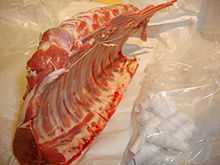Rack of lamb


A rack of lamb or carré d'agneau (though this may also refer to other cuts) is a cut of lamb cut perpendicularly to the spine, and including 16 ribs or chops. At retail, it is usually sold 'single' (sawn longitudinally and including the 8 ribs on one side only), but may also be sold as a "double rack of lamb", with the ribs on both sides.[1]
Rack of lamb is usually roasted, sometimes first coated with an herbed breadcrumb persillade. The tips of the bones are sometimes decorated with paper frills called manchettes.[2]
Crown roast
Two or three single racks of lamb tied into a circle make a "crown roast of lamb".[1] Crown roasts are sometimes cooked with (ground-lamb) stuffing in the middle.
Frenching
Rack of lamb is often "frenched" (USA term), that is, the rib bones are exposed by cutting off the fat and meat covering them. Typically, three inches of bone beyond the main muscle (the rib eye or Longissimus dorsi) are left on the rack, with the top two inches exposed.[1]
Notes
- ↑ 1.0 1.1 1.2 James Peterson, Glorious French Food: A Fresh Approach to the Classics, 2002, p. 508-9
- ↑ Mary Ellen Snodgrass (29 November 2004). "P". Encyclopedia of Kitchen History. Taylor & Francis. p. 717. ISBN 9780203319178. Retrieved 10 November 2013.